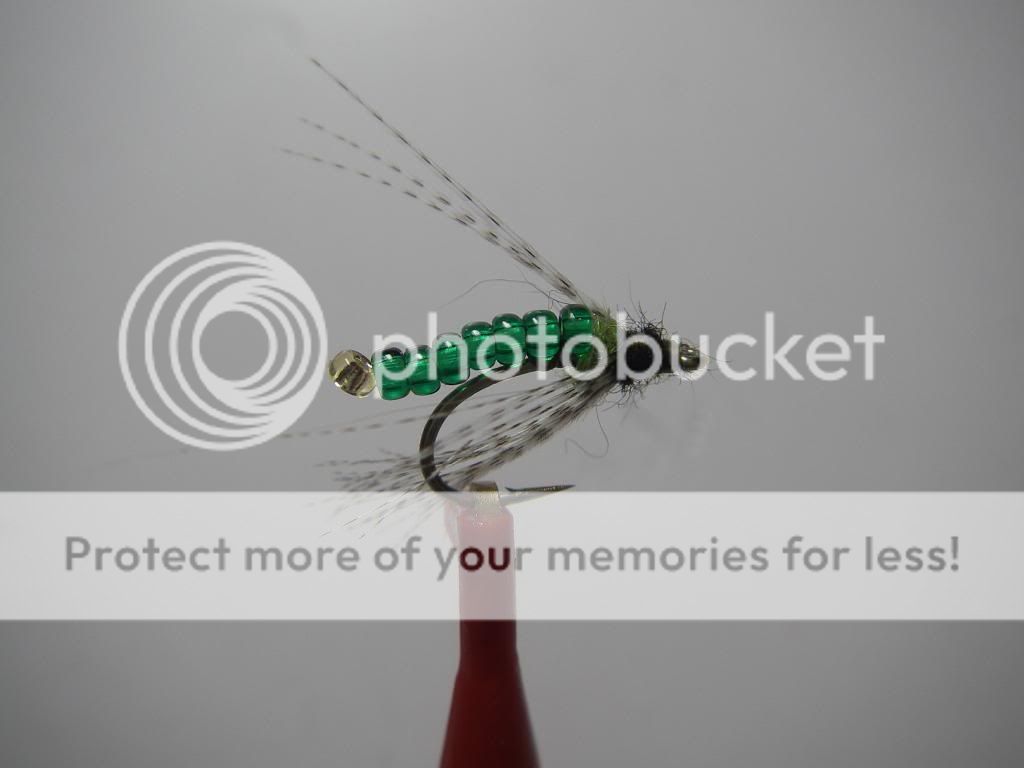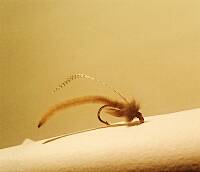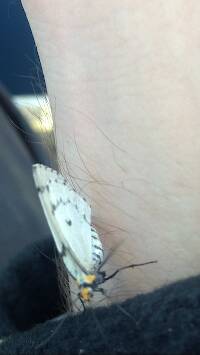
Hex Mayflies
Hexagenia limbata
The famous nocturnal Hex hatch of the Midwest (and a few other lucky locations) stirs to the surface mythically large brown trout that only touch streamers for the rest of the year.
Featured on the forum

Nymphs of this species were fairly common in late-winter kick net samples from the upper Yakima River. Although I could not find a key to species of Zapada nymphs, a revision of the Nemouridae family by Baumann (1975) includes the following helpful sentence: "2 cervical gills on each side of midline, 1 arising inside and 1 outside of lateral cervical sclerites, usually single and elongate, sometimes constricted but with 3 or 4 branches arising beyond gill base in Zapada cinctipes." This specimen clearly has the branches and is within the range of that species.

Troutnut is a project started in 2003 by salmonid ecologist Jason "Troutnut" Neuswanger to help anglers and
fly tyers unabashedly embrace the entomological side of the sport. Learn more about Troutnut or
support the project for an enhanced experience here.
Feathers5
Posts: 287
Posts: 287
Feathers5 on Apr 1, 2015April 1st, 2015, 5:52 am EDT
I tied many of these type of flies last year along with with the La Fontaine Deep Sparkle Pupa, but I got poor results. I fished them as a dropper, the fly nearest me in a two-fly rig. Should I be fishing them down in the stream bed?
Entoman on Apr 1, 2015April 1st, 2015, 6:38 am EDT
Depends on conditions. If the timing is right for pupa (the adults are popping off without a swarm present), I fish them deep until the fish start to show. My favorites are the Pettis Glass-bead and the Poopah, both with beads at the head. They are also excellent searching/attractor patterns that are usually on my line sometime during the day in caddis season. For shallow needs I use a pharate imitation of my own design. I think I've posted it many times.
"It's not that I find fishing so important, it's just that I find all other endeavors of Man equally unimportant... And not nearly as much fun!" Robert Traver, Anatomy of a Fisherman
Martinlf on Apr 1, 2015April 1st, 2015, 12:26 pm EDT
Kurt, what hooks do you favor for the Pettis and the Poopah? I think I'll tie some up for this season. Also, given Eric's photo, what do you think of some sparse CDC wings for pharates?
"He spread them a yard and a half. 'And every one that got away is this big.'"
--Fred Chappell
--Fred Chappell
Lastchance on Apr 1, 2015April 1st, 2015, 1:48 pm EDT
What in the hell is a pharate? A pupa? No, I'm not looking it up. Please speak English.
Entoman on Apr 1, 2015April 1st, 2015, 10:26 pm EDT
Hi Louis,
I like the Tiemco 3761 or any 1X nymph hook for the Poopah. The extra length gives room for the bead and lashing down the micro chenille with enough rib wraps. Keep the abdomen stub short!
I use the Tiemco 2457 for the Pettis GB.
Curiously, the GB out fishes the Poopah for green Pupae and the field reverses for the Amber critters! The difference is so stark that I no longer carry them in any other colors but Amber for the Poopah and green for the Pettis GB.
My feelings are hurt, Bruce... Didn't you read my posts in the other thread still up? ;)
I like the Tiemco 3761 or any 1X nymph hook for the Poopah. The extra length gives room for the bead and lashing down the micro chenille with enough rib wraps. Keep the abdomen stub short!
I use the Tiemco 2457 for the Pettis GB.
Curiously, the GB out fishes the Poopah for green Pupae and the field reverses for the Amber critters! The difference is so stark that I no longer carry them in any other colors but Amber for the Poopah and green for the Pettis GB.
My feelings are hurt, Bruce... Didn't you read my posts in the other thread still up? ;)
"It's not that I find fishing so important, it's just that I find all other endeavors of Man equally unimportant... And not nearly as much fun!" Robert Traver, Anatomy of a Fisherman
Crepuscular on Apr 2, 2015April 2nd, 2015, 9:08 am EDT
Martinlf on Apr 2, 2015April 2nd, 2015, 11:58 am EDT
Eric, would you be willing to include a materials list? The "wing" is especially hard for me to figure out.
"He spread them a yard and a half. 'And every one that got away is this big.'"
--Fred Chappell
--Fred Chappell
Gutcutter on Apr 3, 2015April 3rd, 2015, 7:44 pm EDT
...Curiously, the GB out fishes the Poopah for green Pupae and the field reverses for the Amber critters! The difference is so stark that I no longer carry them in any other colors but Amber for the Poopah and green for the Pettis GB...
A compromise fly for you Kurt? Sorry if I posted this fly already.

My inspiration for this Grannom imitation was both the Pettis glass bead and the Poopah
All men who fish may in turn be divided into two parts: those who fish for trout and those who don't. Trout fishermen are a race apart: they are a dedicated crew- indolent, improvident, and quietly mad.
-Robert Traver, Trout Madness
-Robert Traver, Trout Madness
Entoman on Apr 4, 2015April 4th, 2015, 4:08 am EDT
I've tried pure glass beads and never done well with them. A hint of glass coming through the buggy nymph dubbing is the ticket.
"It's not that I find fishing so important, it's just that I find all other endeavors of Man equally unimportant... And not nearly as much fun!" Robert Traver, Anatomy of a Fisherman
Planettrout on Apr 6, 2015April 6th, 2015, 7:08 am EDT
What in the hell is a pharate? A pupa? No, I'm not looking it up. Please speak English.
" When pupation is complete the caddis emerge as adults enclosed in a temporary integument. These are known as pharate adults, though anglers frequently refer to them as pupae. The pharate adults use their jaws to cut their way from the cocoon and case. Then they swim to the surface to emerge, or crawl from the water up plants, stones, or other structure bridging the meniscus. The pharate adults of many species have long median legs fringed with hairs. These paddle like legs allow them to swim effectively. Their wings and antenna are usually folded back along their abdomen. The pharate adults are coloured shades of green, orange, cream, brown or grey. Their thorax and folded wings often appear much darker."
That being said, I have enjoyed a lot of success with Barr's Graphic Caddis - fished deep, using the Leisenring Lift and swung...
< />

Tan Graphic Caddis...
...and the variation on the BGC, the Bubblebutt Caddis...
< />

Bubblebutt Caddis...
...more so than with Tim Fox's Poopah...
http://stevenojai.tripod.com/poopah.htm
PT/TB
Daughter to Father: "How many arms do you have, how many fly rods do you need?"
http://planettrout.wordpress.com/
http://planettrout.wordpress.com/
Oldredbarn on Apr 6, 2015April 6th, 2015, 12:25 pm EDT
My feelings are hurt, Bruce... Didn't you read my posts in the other thread still up? ;)
Kurt...I do believe that Brucie speaks English and I think I've heard him swear in Italian, but it's hard to understand him sometimes because he's usually calling out to you from under the water...He gets dunked more often than a circus clown in a carnival dunk-tank. :)
I sometimes think he's a pharate adult...;)
" When pupation is complete the caddis emerge as adults enclosed in a temporary integument. These are known as pharate adults, though anglers frequently refer to them as pupae. The pharate adults use their jaws to cut their way from the cocoon and case. Then they swim to the surface to emerge, or crawl from the water up plants, stones, or other structure bridging the meniscus. The pharate adults of many species have long median legs fringed with hairs. These paddle like legs allow them to swim effectively. Their wings and antenna are usually folded back along their abdomen. The pharate adults are coloured shades of green, orange, cream, brown or grey. Their thorax and folded wings often appear much darker."
Nice looking flies there PT! I'm not sure where that quote is from, but I think it interesting that there is mention of the critter "swimming" to the surface and not inflating with gas like a little balloon.
Re-read Paul's link to Gary Borger, not sure which post, and Bob Wyatt, p126 of his book, "What Trout Want: The Educated Trout and Other Myths"...
The article by the Norwegian biologist intrigued me, so I did some follow-up research of my own, including some correspondence with entomologists at several American and British universities, as well as the British Natural History Museum. I was surprised to learn that the gas bubble effect was not documented in any scientific literature that I could find, and neither the biologists I corresponded with nor their colleagues had any knowledge of it, nor could they find any reference to the phenomenon.
p127 The caddis emerger, at least those observed by science, does not ascend to the surface by the buoyancy produced by this bubble, it swims or crawls its way up. Finally, like all insects, the pharate caddis splits and sheds its exoskeleton through a combination of blood pressure and muscle contractions. It withdraws its fully formed legs and antennae from their chitinous sheath.
p127 cont The gas bubble phenomenon is undocumented in any scientific study because pharate caddisflies don't exude a gas that creates a bubble between their instar cuticles. The insect doesn't pump itself up like a miniature balloon. As far as we know, no insect does, and caddisflies are, after all, insects. The nearest thing to itis a gel-type molting fluid that the insects produce to help them ease out of the pupal skin, but this lubricating substance is a microthin layer between the two cuticles, not a visible bubble.
He then goes on to mention as Gary Borger did in the article Paul linked us to, that the "bubble" is probably from the egg layers who surround themselves with an air bubble before laying their eggs under the surface, and then the bubble pops as the critter finds itself back at the surface...Looking everything like an emerging bug.
Spence
"Even when my best efforts fail it's a satisfying challenge, and that, after all, is the essence of fly fishing." -Chauncy Lively
"Envy not the man who lives beside the river, but the man the river flows through." Joseph T Heywood
"Envy not the man who lives beside the river, but the man the river flows through." Joseph T Heywood
Planettrout on Apr 7, 2015April 7th, 2015, 2:02 pm EDT
Ralph Cutter, who actually swims with the bugs, might take issue with the notion that gas bubbles do not develop within the Caddis pupal sheath:
http://www.flyline.com/entomology/glossosoma_caddisflies/
That particular Caddis, Glossosoma, is probably the most overlooked bug in the Eastern Sierras. I have taken some very large Trout ,in the evening, on the East Walker River with a Craig Matthews designed Glossosoma pattern with a bubble sheath.I also dab a little Frog's Fanny on the pattern before use...That fly is most probably taken as the adult female, diving beneath the surface to lay it's eggs or returning to the surface. The late Ed Story was the first to suggest this little trick for diving female Caddis...
PT/TB
http://www.flyline.com/entomology/glossosoma_caddisflies/
That particular Caddis, Glossosoma, is probably the most overlooked bug in the Eastern Sierras. I have taken some very large Trout ,in the evening, on the East Walker River with a Craig Matthews designed Glossosoma pattern with a bubble sheath.I also dab a little Frog's Fanny on the pattern before use...That fly is most probably taken as the adult female, diving beneath the surface to lay it's eggs or returning to the surface. The late Ed Story was the first to suggest this little trick for diving female Caddis...
PT/TB
Daughter to Father: "How many arms do you have, how many fly rods do you need?"
http://planettrout.wordpress.com/
http://planettrout.wordpress.com/
Entoman on Apr 10, 2015April 10th, 2015, 5:18 pm EDT
Tim,
I don't think Ralph disagrees. If you read your quote of his carefully he acknowledges that the gas bubble pupa probably imitates the diving adult.
I don't think Ralph disagrees. If you read your quote of his carefully he acknowledges that the gas bubble pupa probably imitates the diving adult.
"It's not that I find fishing so important, it's just that I find all other endeavors of Man equally unimportant... And not nearly as much fun!" Robert Traver, Anatomy of a Fisherman
Quick Reply
Related Discussions
Topic
Replies
Last Reply
3
Oct 3, 2008
by GONZO
by GONZO










